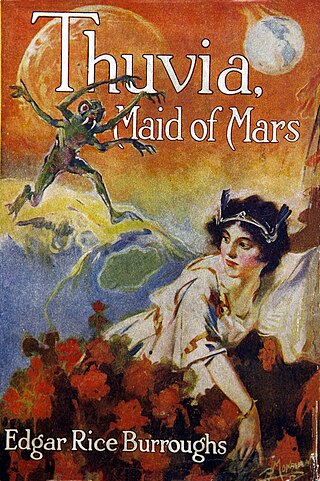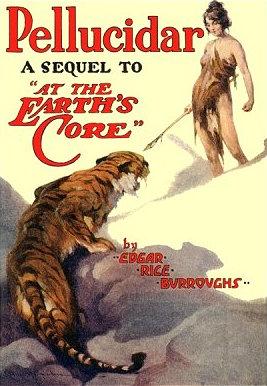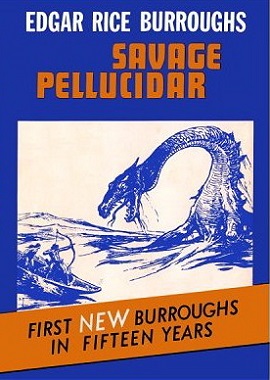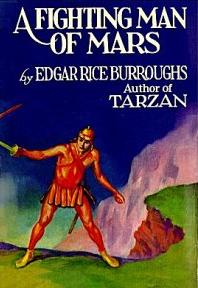
Edgar Rice Burroughs was an American writer, best known for his prolific output in the adventure, science fiction, and fantasy genres. Best known for creating the characters Tarzan and John Carter, he also wrote the Pellucidar series, the Amtor series, and the Caspak trilogy.

A Princess of Mars is a science fantasy novel by American writer Edgar Rice Burroughs, the first of his Barsoom series. It was first serialized in the pulp magazine All-Story Magazine from February–July, 1912. Full of swordplay and daring feats, the novel is considered a classic example of 20th-century pulp fiction. It is also a seminal instance of the planetary romance, a subgenre of science fantasy that became highly popular in the decades following its publication. Its early chapters also contain elements of the Western. The story is set on Mars, imagined as a dying planet with a harsh desert environment. This vision of Mars was based on the work of the astronomer Percival Lowell, whose ideas were widely popularized in the late 19th and early 20th centuries.

Thuvia, Maid of Mars is a science fantasy novel by American writer Edgar Rice Burroughs, the fourth of the Barsoom series. The principal characters are Carthoris and Thuvia of Ptarth, each of whom appeared in the previous two novels.

The Warlord of Mars is a science fantasy novel by American writer Edgar Rice Burroughs, the third of his Barsoom series. Burroughs began writing it in June, 1913, going through five working titles; Yellow Men of Barsoom, The Fighting Prince of Mars, Across Savage Mars, The Prince of Helium, and The War Lord of Mars.

The Chessmen of Mars is a science fantasy novel by American writer Edgar Rice Burroughs, the fifth of his Barsoom series. Burroughs began writing it in January, 1921, and the finished story was first published in Argosy All-Story Weekly as a six-part serial in the issues for February 18 and 25 and March 4, 11, 18 and 25, 1922. It was later published as a complete novel by A. C. McClurg in November 1922.

The Master Mind of Mars is a science fantasy novel by American writer Edgar Rice Burroughs, the sixth of his Barsoom series. Burroughs' working titles for the novel were A Weird Adventure on Mars and Vad Varo of Barsoom. It was first published in the magazine Amazing Stories Annual vol. 1, on July 15, 1927. The first book edition was published by A. C. McClurg in March, 1928.

Pirates of Venus is a science fantasy novel by American writer Edgar Rice Burroughs, the first book in the Venus series, the last major series in Burroughs's career. It was first serialized in six parts in Argosy in 1932 and published in book form two years later by Edgar Rice Burroughs, Inc. The events occur on a fictionalized version of the planet Venus, known as "Amtor" to its inhabitants.

The Land That Time Forgot is a fantasy novel by American writer Edgar Rice Burroughs, the first of his Caspak trilogy. His working title for the story was "The Lost U-Boat". The sequence was first published in Blue Book Magazine as a three-part serial in the issues for August, October, and December 1918. The complete trilogy was later combined for publication in book form under the title of the first part by A. C. McClurg in June 1924. Beginning with the Ace Books editions of the 1960s, the three segments have usually been issued as separate short novels.

At the Earth's Core is a 1914 fantasy novel by American writer Edgar Rice Burroughs, the first in his series about the fictional "hollow earth" land of Pellucidar. It first appeared as a four-part serial in All-Story Weekly from April 4 to 25, 1914. It was first published in book form in hardcover by A. C. McClurg in July, 1922.

Lieut. Gullivar Jones: His Vacation is a novel by English writer Edwin Lester Arnold, combining elements of both fantasy and science fiction, first published in 1905. Its lukewarm reception led Arnold to stop writing fiction. It has since become his best-known work, and is considered important in the development of 20th century science fiction in that it is a precursor and likely inspiration to Edgar Rice Burroughs's classic A Princess of Mars (1917), which spawned the planetary romance and sword and planet genres. Ace Books reprinted Arnold's novel in paperback in 1964, retitling it Gulliver [sic] of Mars. A more recent Bison Books edition (2003) was issued as Gullivar of Mars, adapting the Ace title to Arnold's spelling.

Pellucidar is a 1915 fantasy novel by American writer Edgar Rice Burroughs, the second in his series about the fictional "Hollow Earth" land of Pellucidar. It first appeared as a five-part serial in All-Story Weekly from May 1 to 29, 1915. It was first published in book form in hardcover by A. C. McClurg in September, 1923. A map by Burroughs of the Empire of Pellucidar accompanied both the magazine and book versions.

Tanar of Pellucidar is a novel by American writer Edgar Rice Burroughs, the third in his series set in the interior world of Pellucidar. It first appeared as a six-part serial in The Blue Book Magazine from March–August 1929. It was first published in book form in hardcover by Metropolitan Books in May 1930.

Land of Terror is a 1944 fantasy novel by American writer Edgar Rice Burroughs, the sixth in his series about the fictional "hollow earth" land of Pellucidar. It is the penultimate novel in the series and the last to be published during Burrough's lifetime. Unlike most of the other books in the Pellucidar series, this novel was never serially published in any magazine because it was rejected by all of Burroughs's usual publishers.

Savage Pellucidar is a 1963 fantasy story collection by American writer Edgar Rice Burroughs, the seventh and final book in his series about the fictional "hollow earth" land of Pellucidar. It was published twelve years after Burroughs's death.

Synthetic Men of Mars is a science fantasy novel by American writer Edgar Rice Burroughs, the ninth of his Barsoom series. It was first published in the magazine Argosy Weekly in six parts in early 1939. The first complete edition of the novel was published in 1940 by Edgar Rice Burroughs, Inc.

Llana of Gathol is a collection of four science fantasy stories by American writer Edgar Rice Burroughs, which were originally published in Amazing Stories in 1941. The first collected edition of Llana of Gathol was published in 1948 with an apparently new foreword. It is the penultimate book in the Barsoom series and the last to be published during Burroughs's lifetime.

John Carter of Mars is the eleventh and final book in the Barsoom series by American writer Edgar Rice Burroughs. It is not a novel, but rather a collection of two John Carter of Mars stories.

Beyond the Farthest Star is a science fiction novel by American writer Edgar Rice Burroughs. The novel consists of two novellas, "Adventure on Poloda" and "Tangor Returns", written quickly in late 1940. The first was published in The Blue Book Magazine in 1942, but the second did not see publication until 1964 when it was featured in Tales of Three Planets along with "The Resurrection of Jimber-Jaw" and The Wizard of Venus.

Barsoom is a fictional representation of the planet Mars created by American pulp fiction author Edgar Rice Burroughs. The first Barsoom tale was serialized as Under the Moons of Mars in pulp magazine The All-Story from February to July 1912 and published compiled as a novel as A Princess of Mars in 1917. It features John Carter, a late-19th-century American Confederate veteran who is mysteriously transported from Earth to the dying world of Mars where he meets and romances the beautiful Martian princess Dejah Thoris. Ten sequels followed over the next three decades, further extending his vision of Barsoom and adding other characters.

Ulysses Paxton is a fictional character created by Edgar Rice Burroughs in his novel The Master Mind of Mars. Within the narrative framework of the novel, Captain Paxton, United States Army Infantry, is a fan of Burroughs' Barsoom series, and after having a shell blow off his legs during trench warfare in World War I, he finds himself drawn across the gulfs of space to Mars like John Carter before him. He sends Burroughs a first person manuscript of his adventures on the dying planet, which Burroughs publishes.



















